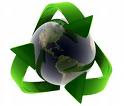Green property not only presents the concept of green nuanced area. But also control and management system that allows water 30 percent of rainwater is absorbed into the ground. Also, the use of green infrastructure such as the use of materials that absorb water.
In our supermarkets offered a 'green bag'. While at the mall, there is an active agent apartment promote 'green building'. Then while on the highway, there are banners also said the contractors 'green'.
Yes, today we are surrounded by a variety of advertising products and services that are given a green color. Then, how can we understand where the real green claims, and which are false ( 'greenwashing')? Let's dig.
Not so fast - did fuck the hell 'greenwashing' that? Did he mean green washing soap?
Uh it was not. Greenwashing is the act actually performed by the company to give the impression to consumers that they are responsible for the environment - but only pretending.
Like what ya? For example a lot.
* The company, which funded the planting thousands of trees but after it was left until the tree dies.
* Paper products, such as copy paper, with the logo "green" (as if this paper is certified as environmentally friendly paper), whereas the certification logo that the company made itself!
* Supermarkets are said to provide shopping bags to reduce plastic bag usage. But in practice, when consumers want to pay, cashier never asked the consumers, "want to wear or carry plastic bags?"
* Housing complexes promoted as eco or green because there are lots of parks / trees, but every house is designed to wasteful use of electricity, does not provide home waste management systems, rainwater from the roof into the gutter (not to the well catchment), there is no public transportation (a result people had to use a car / motorcycle for berkaktivitas) and do not provide safe facilities for pedestrians and bicycle users.
* The company makes events such as concerts, bazaars, and festivals with the label "green", while in practice there are a lot of garbage scattered (eg, brochures garbage, plastic and Styrofoam); garbage cleaned only by a janitor and thrown into the landfill, not sorted / recyclable; committee consumption given in styrofoam boxes and plastic cups; visitors are not encouraged to use public transport or bicycles; and events using a very large electricity.
* Companies that make the environment, whereas the product harmful to the environment or the company is not responsible for managing the waste from the product packaging.
Tips to identify the product or labels that smelled of greenwashing
1. Writing using the language of marketing is not clear ( "Go green with fun bike tour follow us!")
2. Use science words that are not there ( "This product is constrained by new substance ecotin or ecoblablabla")
3. Claims without proof ( "By purchasing this product you will reduce carbon emissions as high as 80%!")
4. Products that clearly threaten the environment or hazardous to health (eg, gasoline, motor / cars, cigarettes, mosquito coils), but which are promoted as environmentally friendly products or healthy.
Tips to reduce greenwashing
* Avoid buying / using products greenwashing
* Contact the manufacturer who did greenwashing and asked them to not lie to customers
* Tell a friend / family about the dangers of greenwashing (emang dangers what? Ditulisan is gk mentioned) and the product is part of greenwashing
Buying products with labels like "green", will only waste your money with a part supporting these producers to continue to damage the environment. Moreover, this will show that you are a consumer who loves to be deceived.

0 comments:
Post a Comment